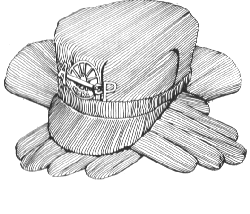
Master Builder – Scenery
Editor’s note: During the past several months we have provided information about the NMRA’s Achievement Program with the hope that this information will inspire members to work on their projects with the goal of becoming a better modeler and a Master Model Railroader.
The intent of this category is for you to demonstrate "the prototypical rendering of scenic effects from the ground up." The type of scenery that you choose to model is entirely up to you. An urban landscape involves just as much scenery (if not more) as a mountain or desert landscape.
-
To Qualify for the Master Builder - Scenery Certificate: Construct a completed section of a model railroad of at
least sixty square feet in O scale, or forty-five square feet in S scale, or thirty-two square feet in HO scale, or
eighteen square feet in N scale or other scales in proportional relationship to HO scale. This completed section must contain
the necessary scenic elements of Terrain, Structures, Background, Lighting, and Realism/Conformity as combined to achieve a
realistic effect using applicable NMRA standards in that particular model railroad scene. The intent of this category is
the prototypical rendering of the scenic elements from the ground up.
It is not necessary to qualify for this certificate by constructing a single section of layout. You can construct several different scenes (such as modules), each of which must be at least eight square feet and of Merit Award quality. Note that modules which earn 87-1/2 or more points using the NMRA's Module contest judging sheet count toward the Master Builder Scenery certificate.
The definitions of the various elements (which may be combined to comprise the setting for the model railroad) shall be:Terrain (35 pts)
- The ground and all natural features such as rocks, water, trees, hills and depressions, as well as man made features such as railroad roadbed, cuts, fills, drainage ditches, embankments, streets and roads, etc.
- Also remember different types of vegetation and the effects of weather and of animals. Remember the detail on streets and roads, whether in urban or rural areas: sewers/storm drains, man-hole covers, shoulders, drainage ditches, cracks, patches, road wear marks, oil stains, and tire ruts in dirt roads.
-
Make the transitions between different types of terrain as smooth as possible. Avoid glaring inconsistencies
such as a New England Farm house surrounded by palm trees. If you are going to have different scenes on your layout
use backdrop dividers or other vision blocks to separate them.
- Structures are considered from the standpoint of prototypical suitability, placement, and appearance as scenic effects - NOT as to construction (which is covered under Master Builder - Structures). This includes bridges, trestles, and culverts, buildings and all other types of structures (towers, power lines, signs, fences, retaining walls, etc.), track and right-of-way features such as turnout controls, signaling structures, crossing gates and shanties, turntables and other service structures, etc.
These are but a few examples - additional features are encouraged. Also remember that structures should be in the ground, not sitting on top of it. Make sure that the appearance of your structures is consistent with your scenery. At the very least, weather it enough to take the "out of the box plastic shine" off of it. Switch machines, if not under the table, should be well disguised (this is one detail that will cause your application to be returned if it is not done). Remember details such as lights over the doors of commercial buildings.
Background (25 pts)
-
Treatment of the wall, backdrop, and/or ceiling to realistically depict depth, distance, horizon, and sky. This doesn't
mean that you have to have a photographic or landscape artist quality background. Your background should continue the
'illusion of reality ' that you are trying to create with your scenery. The background should match the scenery, and the
transition where the two of them meet is smooth and/or hidden. One good question to ask is: Is there enough good background
to allow a photo to be taken without showing other parts of the room?
-
Illumination effects from three aspects:
- railroad cars, signals, etc.
- buildings, streets, and roads, etc.
-
overall lighting effects - day and/or night.
Realism / Conformity (25 pts)
In the other four judging areas, the judges evaluate what you were trying to do - what you remember-ed to include in your scene. In this one, they evaluate how well you did what you were trying to do.
Your entire layout does not have to be completed to be judged - just enough to meet the minimum space requirements given above. However, the areas which are not to be judged should be blocked off (visually) from those that are.
-
Prepare a set of photographs (video tape presentation is acceptable) and a written description clearly describing the intended setting
of the model railroad and the scenic details including towns or cities in the area being judged. These photos don't have to be professional
quality - that isn't what is being judged. However, there should be at least one over-all picture of the layout, and pictures of all the
parts which are being judged. Each picture should have an accompanying description.
-
Prepare a description of the materials and methods of construction used in creating various features of Terrain, Background, and Lighting.
These can be simple statements - nothing elaborate is required. Attach one copy of materials in Sections 2 & 3 to the Statement of Qualification
(SOQ) for use by the judges in determining the effectiveness of the craftsmanship displayed by the member requesting certification.
This information was adapted from the NMRA website and is offered for the information of our readers. For the most complete and current information, go to www.nmra.org. Additional information is part of an ongoing series in Scale Rails, NMRA’s membership magazine.
